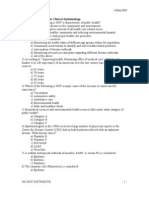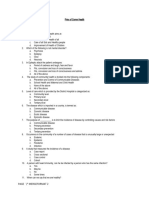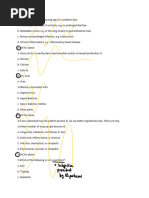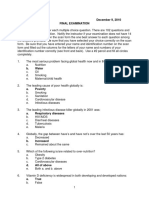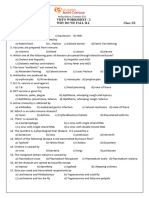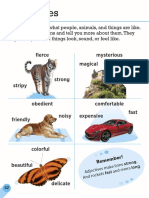SFH-module 5 new
SFH-module 5 new
Uploaded by
shettykavan006Copyright:
Available Formats
SFH-module 5 new
SFH-module 5 new
Uploaded by
shettykavan006Copyright
Available Formats
Share this document
Did you find this document useful?
Is this content inappropriate?
Copyright:
Available Formats
SFH-module 5 new
SFH-module 5 new
Uploaded by
shettykavan006Copyright:
Available Formats
Scientific Foundations of Health-BSFHK108
Module -5
SYLLABUS
Preventing and fighting against diseases for good health :
Process of infections and reasons for it, How to protect from different types of transmitted
infections such as…., Current trends of socio economic impact of reducing your risk of
disease, How to reduce risks for good health, Reducing risks and coping with chronic
conditions, Management of chronic illness for Quality of life,Health and Wellness of youth :
a challenge for the upcoming future Measuring of health and wealth status
1. Quality of Life can tell us about:
a. Whether the patient’s illness is diminishing
b. Whether various aspects of well-being are improving
c. Can predict resilience
d. Can predict vulnerability
2. Depression occurs at a rate of about _______ among patients with chronic liver
disease.
a. 5% b. 10%
c. 20% d. 30%
3. Which of the following is a hereditary disease?
a) Rabies b) Colour blindness
c) Polio d) Small pox
4. Deficiency of Vitamin B complex causes
a) Dermatitis b) Peliagra
c) Rickets d) Scurvy
5. Select out the odd one
a) DPT – Vaccine b) DOTS – TB
c) AB+ – Universal donor d) Adrenalin – Harmone
6. Which of the following is not a hereditary disease?
a) Haemophilia b) Hypertrichosis
c) Encephalitis d) Thalassemia
21SFH19-DEPT.OF CHEMISTRY-AJIET Page 1
7. Hepatitis is caused due to
a) Infected blood transfusion b) Use of contaminated water
c) Addiction of drug d) Dialysis
8. The type of hepatitis which caused after blood transfusion
a) Hepatitis-A b) Hepatitis-B
c) Hepatitis-C d) Hepatitis-D
9. A kind of an injury or damage, which results in the premature death of all the
nearby cells in a tissue or an organ through autolysis is called _______.
a) Neurosis b) Necrosis
c) Apoptosis d) Cellular senescence
10. Which of the following diseases has been eradicated?
a) Smallpox b) Rinderpest
c) Polio d) All of the above
11 The _________ is at its largest in children, but with the onset of puberty, it
eventually shrinks and gets replaced by fat.
a) Thymus b) Hypothalamus
c) Parathyroid gland d) None of the above
12 Human Immunodeficiency Virus causes aids by attacking a type of white
blood cell called_______.
a) CD4 b) CD3
c) CD8 d) None of the above
13 A chronic illness is best described as
a.a long-term condition that has the ability to be treated but never cured
b.a condition which can be treated and cured with the correct therapy and/or medication
c.a condition which may be treated and will be cured within six months to one year
d.a condition which has the ability to be treated and cured immediately
14 What is a common side effect of a chronic illness and can affect up to one-third of
those who suffer from chronic illnesses?
a.Depression b. Nausea
c. Diarrhea d.Fatigue
15 What are the reasons for taking drugs?
a)To feel good b)To feel better
c)To do better d)All of the above
16 Social health hazards includes
a)Stigma b) Anti social behavior
21SFH19-DEPT.OF CHEMISTRY-AJIET Page 2
c)Higher crime records d)All of the above
17 Risk factors that increases a person’s illness or injury due to
a)Smoking b)Extreme physical activity
c)Alcohol drinking d)All of the above
18 Wellness dimensions are
a)4 b)2
c)6 d)8
19 Symptoms of substance use disorder is
a)Impaired control b)Social Problems
c)Risky use d)All of the above
20 STIs(sexually transmitted diseases)sare most common in which age group?
a.Teens and young adults up to age 24 b. B. People ages 30 to 45
c. People 60 and older d. All of the above
21 Which is the most common STI caused by bacteria?
a. Gonorrhea b. Syphilis
c. Chlamydia d. Genital warts
22 Which of these is a health problem that can be caused by STIs in women?
a. Pelvic inflammatory disease (PID) b. Ectopic pregnancy
c. Higher risk for cervical cancer d. All of the above
23 Which of the following CANNOT be transmitted via infectious droplets?
Rubella Common cold
Influenza None of the above
24. What proportions of patients with coronary heart disease are thought to be clinically
depressed?
a.A quarter b. A third (or more)
c. All d. Half
25. Which of the following is one of the adaptive tasks required as a result of chronic
illness
a.Managing dietary needs
b.Maintaining spiritual beliefs
c. Dealing with changes in relationships with family and friends
d.Rising to the challenges of the illness
21SFH19-DEPT.OF CHEMISTRY-AJIET Page 3
26. The benefits of social support in times of poor health or stress include:
a.less distress/better emotional adjustment.
b.increased adherence to treatment and self-care.
c. reduced mortality or increased survival.
d. All of the above
27. The purpose is to limit the incidence of disease by controlling causes and risk factors
a. Primordial prevention b. Primary prevention
c. Secondary prevention d. Tertiary prevention
28 Occurrence in the community of a number of cases of disease that is unusually large
or unexpected
a. Endemic b. Epidemic
c. Pandemic d. Infection
32 How are infectious diseases, such as colds and influenza, most commonly spread?
A. Breathing viruses in air B. Hand-to-face contact
C. Drinking infected water D. Eating contaminated food
33 Which of the following increases your risk for type 2 diabetes?
a. Not getting enough exercise b. Eating too much sugar
c. Being overweight d. a and c
34 What is the most common way for a virus to kill a cell?
a) Dissolves the cellular membrane b) Induces apoptosis via caspases
c) Fragments cellular DNA d) Totally blocks cellular transcription
35 Many virus infections result in immune pathology, this is caused predominantly by
which of the following?
a) A cytokine storm
b) Antibody mediated reactions
c) A response of killer T cells (CD-8)
d) A decline in function of the immune system
36 Community health aims -
a) Improvement of health of all
b) care of infant and old
c) improvement of health of children
d) care of infirms
37 Which one of the following is an unhealthy habit -
a) eating without washing ones hand
b) sharing food
c) bathing twice a day
d) drinking boiled water
38. In 2015 the global prevalence of HIV was -
21SFH19-DEPT.OF CHEMISTRY-AJIET Page 4
a) 0.8 percent
b) 0.4 percent
c) 0.6 percent
d) 0.2 percent
39. The influence of families, schools and and neighbourhoods in explaining social inequalities
in health can be categorised in which of the following systems?
a) microsystem
b) mesosystem
c) exosystem
d) macrosystem
40. Cleanliness , physical exercise ,rest and sleep are a part of
a) personal hygiene
b) hygiene
c) social hygiene
d) none of the above
41. Which philosopher was central to the conceptualization of human beings as composed of
mind and body ?
a) Rene Descartes
b) Confucius
c) Plato
d) John Locke
42. In H J Eysenck’s 20th century theory of personality how did he reinterpret the classical
phlegmatic temperament?
a) stable introvert
b) stable extravert
c) unstable introvert
d) unstable extravert
43. A mentally sick person has
a) Tendency to get upset with change of routine
b) Feeling of friendship and trust for all
c) Tendency to perform all the daily chores by oneself
d) Tendency to solve all the problems without aid of others
44. In , blood glucose homeostasis ceases to function because the beta cells of the
pancreatic islets are destroyed.
a) type 1 diabetes mellitus
b) type 2 diabetes mellitus
c) gestational diabetes
d) both type 2 diabetes mellitus and gestational diabetes
45 Which of the following diseases is also called as “Salmonella enterica serotype Typhi”?
a) Typhoid
b) Malaria
c) Diarrhea
21SFH19-DEPT.OF CHEMISTRY-AJIET Page 5
46. Which of the following is the main cause for transmission of the Hepatitis virus?
a) The bite of a mosquito
b) Sharing drug needles
c) Drinking contaminated water
d) All of the above
47. Which of the following statements is true about contamination?
a) Contamination is caused by the entry of germs by an insect bite
b) Contamination is caused by the entry of germs by an animal bite
c) Contamination is caused by the entry of germs into drinking water or edible
foods.
d) None of the above
48. Which of the following factors is necessary for a healthy person
a) Vaccination
b) Balanced diet
c) Personal hygiene
d) All of the above
49. Pelvis consists of number of bones
a) 3
b) 4
c) 5
d) 6
50. Which part of eye can be transplanted?
a) Retina
b) Cornea
c) Optic nerves
d) Complete eye
21SFH19-DEPT.OF CHEMISTRY-AJIET Page 6
You might also like
- Epidemiology MCQs For Entrance Examination of Master of Public HealthDocument33 pagesEpidemiology MCQs For Entrance Examination of Master of Public HealthBijay kumar kushwaha69% (13)
- SFH QuestionsDocument54 pagesSFH QuestionsRakshitha Devadiga100% (3)
- Quiz Public HealthDocument26 pagesQuiz Public HealthMedShare89% (27)
- Questions For Community Medicine MD 4Document11 pagesQuestions For Community Medicine MD 4Bindashboy0100% (2)
- EXAM_COMMUNITY HEALTH_HSC 108Document7 pagesEXAM_COMMUNITY HEALTH_HSC 108NkengfuaNo ratings yet
- Princ of Com HealthDocument3 pagesPrinc of Com Healthramadhani mangapiNo ratings yet
- Emerging Infectious DiseasesDocument24 pagesEmerging Infectious Diseasesminahilsafdar14No ratings yet
- CHN_reviewer_2.docxDocument1 pageCHN_reviewer_2.docxnathanjancanales21No ratings yet
- 21SFH19, 29 JAN-FEB 2023 Scientific Foundation of HealthDocument4 pages21SFH19, 29 JAN-FEB 2023 Scientific Foundation of Healthsimransunilkumar55No ratings yet
- MCQ - May, 2015Document7 pagesMCQ - May, 2015ahmed nasser100% (1)
- G8 HEALTH For HealthDocument9 pagesG8 HEALTH For Healthqjsmedina01No ratings yet
- 110 TOP SOCIAL and PREVENTIVE Multiple Choice Questions and Answers PDF 2019Document24 pages110 TOP SOCIAL and PREVENTIVE Multiple Choice Questions and Answers PDF 2019SunilKumar D100% (1)
- نماذج احصاءDocument70 pagesنماذج احصاءAsem AlmeerabiNo ratings yet
- general sessionsDocument9 pagesgeneral sessions58ssgvfk2kNo ratings yet
- Midterm Key 2011 PDFDocument12 pagesMidterm Key 2011 PDFAbubakar Abdhoo100% (2)
- Final McqsDocument11 pagesFinal McqsShaban Yasser100% (1)
- Final Key 12-2010 PDFDocument14 pagesFinal Key 12-2010 PDFAbubakar AbdhooNo ratings yet
- PHC ObjectivesDocument22 pagesPHC ObjectivessaheeberhmekyauNo ratings yet
- 30th January 2021 Combined Test (PSM, Pharmacology, Forensic Medicine, Microbiology, Pathology)Document14 pages30th January 2021 Combined Test (PSM, Pharmacology, Forensic Medicine, Microbiology, Pathology)siddhantaNo ratings yet
- (INFECTIOUS) تجميعة سنواتDocument71 pages(INFECTIOUS) تجميعة سنواتمحمدا الهادي الشارفNo ratings yet
- Mvj22sfhk28 Module 5Document3 pagesMvj22sfhk28 Module 5rahilrafeek255No ratings yet
- H-Public HealthDocument12 pagesH-Public Healthخالد المهدي خالد شاهين100% (2)
- SFH - Cie1 - QP 1Document2 pagesSFH - Cie1 - QP 1supriyaharlapurNo ratings yet
- CHN Paper 2-1Document25 pagesCHN Paper 2-1Asad MirajNo ratings yet
- Revision questions-2Document2 pagesRevision questions-2glorias.pamojaNo ratings yet
- D.pharm I_Social PharmacyDocument2 pagesD.pharm I_Social Pharmacydipusharma6465No ratings yet
- Public Health - MartiNemerow - Practice Test - P2C1 PDFDocument14 pagesPublic Health - MartiNemerow - Practice Test - P2C1 PDFArly TolentinoNo ratings yet
- Set B PHC AnswerDocument11 pagesSet B PHC AnswerDiane100% (1)
- 21SFH29 JUNE-JULY 2023 Scientific Foundation of HealthDocument4 pages21SFH29 JUNE-JULY 2023 Scientific Foundation of Healthsimransunilkumar55No ratings yet
- MCQS of public healthDocument14 pagesMCQS of public healthNAX GAMENo ratings yet
- CHN MybDocument6 pagesCHN MybuzmaaftabNo ratings yet
- 9 Science Exemplar Chapter 13Document5 pages9 Science Exemplar Chapter 13AKHILA.SURESHNo ratings yet
- 21SFH29 DEC. 2023-JAN 2024 Scientific Foundations of HealthDocument4 pages21SFH29 DEC. 2023-JAN 2024 Scientific Foundations of Healthsimransunilkumar55No ratings yet
- Ws-3&4-Why Do We Fall IllDocument4 pagesWs-3&4-Why Do We Fall Illphysicsbooks.storeNo ratings yet
- ?2023-05-29 @PCM BM2Document24 pages?2023-05-29 @PCM BM2VineeNo ratings yet
- Disease Unit ExamDocument3 pagesDisease Unit ExamdavidNo ratings yet
- Why Do We Fall Ill PDFDocument4 pagesWhy Do We Fall Ill PDFmkmattaNo ratings yet
- 1.PAPER I PU DEC 2024Document3 pages1.PAPER I PU DEC 2024shubhamgautam2519No ratings yet
- TextDocument7 pagesTextobail nadeemNo ratings yet
- SFH MCQ 3Document12 pagesSFH MCQ 3Shamanth MNo ratings yet
- Hiv Aid and Sti Final ExamDocument5 pagesHiv Aid and Sti Final ExammarataningutukuNo ratings yet
- Behav ADocument11 pagesBehav ADaniel MmaryNo ratings yet
- Ws-2-Why Do We Fall IllDocument6 pagesWs-2-Why Do We Fall Illphysicsbooks.storeNo ratings yet
- PHN End 1ST Year Exam Jul 09Document6 pagesPHN End 1ST Year Exam Jul 09chobeledorisNo ratings yet
- MCQs For Professor SirDocument6 pagesMCQs For Professor SirnadiaNo ratings yet
- MCQsDocument6 pagesMCQsvishalsingh00uNo ratings yet
- Nel Coc Exam 2021Document18 pagesNel Coc Exam 2021mike markNo ratings yet
- MEDICINEDocument20 pagesMEDICINEMwanza Kabachele Henry0% (1)
- GIT, HBS, Nutrition, Metabo: Department of Community Medicine Mbbs Ii Year Annual Exam 2002 MCQDocument2 pagesGIT, HBS, Nutrition, Metabo: Department of Community Medicine Mbbs Ii Year Annual Exam 2002 MCQEliza SparkNo ratings yet
- 2116Document4 pages2116NISHANTNo ratings yet
- Nle Quickfix 23-7Document4 pagesNle Quickfix 23-7BasicEdit CocoDurianNo ratings yet
- 10B 2017-1Document9 pages10B 2017-1TheBoss 20100% (3)
- 13 WHY DO WE FALL ILL ChapterDocument10 pages13 WHY DO WE FALL ILL ChapterAKHILA.SURESHNo ratings yet
- Health Assistant Loksewa ExamDocument12 pagesHealth Assistant Loksewa Exam2000loveking67% (3)
- Apmc Prev Med CompilationDocument72 pagesApmc Prev Med CompilationNicole SantosNo ratings yet
- 28.3, Why Do We Fall Ill Ncert MCQDocument5 pages28.3, Why Do We Fall Ill Ncert MCQHimmat NahariaNo ratings yet
- Surviving a Viral Pandemic: Thru the Lens of Naturopathic Medical DoctorFrom EverandSurviving a Viral Pandemic: Thru the Lens of Naturopathic Medical DoctorNo ratings yet
- The COVID-19 Enigma: Mysteries and Epiphany of A New CoronavirusFrom EverandThe COVID-19 Enigma: Mysteries and Epiphany of A New CoronavirusNo ratings yet
- COVID 1984: The Pandemic, The Great Reset and the New World Order: A comprehensive and evidence-based investigation of the Covid-19 crisis, including data, facts, backgrounds, forecasts and solutionsFrom EverandCOVID 1984: The Pandemic, The Great Reset and the New World Order: A comprehensive and evidence-based investigation of the Covid-19 crisis, including data, facts, backgrounds, forecasts and solutionsNo ratings yet
- Ophthal MnemonicsDocument22 pagesOphthal Mnemonicsjunkemail860% (1)
- Curriculum Vitae: Kuldeep KumarDocument5 pagesCurriculum Vitae: Kuldeep KumarNehal RupaniNo ratings yet
- Kitchen Tools and Equipment 2024Document7 pagesKitchen Tools and Equipment 2024Mak mak MacasaetNo ratings yet
- Degaussing N Magnetic MinesDocument3 pagesDegaussing N Magnetic MinesGus MellonNo ratings yet
- The International Jewish Cook BookDocument383 pagesThe International Jewish Cook BookBrankoSalvari100% (1)
- Out of School YouthDocument7 pagesOut of School YouthApple Ermida BanuelosNo ratings yet
- Teaching Demo RubricDocument2 pagesTeaching Demo RubricBeverage A. SarzaNo ratings yet
- Sadat Apparels LTD PresetationDocument49 pagesSadat Apparels LTD Presetationmd.rajib sardarNo ratings yet
- Cell Preparation For Genomics FlyerDocument20 pagesCell Preparation For Genomics Flyersara samanianNo ratings yet
- Book 4 Music AlphabeticalDocument1 pageBook 4 Music AlphabeticaltestnationNo ratings yet
- Page 1 of 3 Free Crochet Pattern: Microspun Goldfish Cat ToyDocument3 pagesPage 1 of 3 Free Crochet Pattern: Microspun Goldfish Cat ToyKaren Lowery MorelandNo ratings yet
- Visual Punctuation Adj and AdvDocument12 pagesVisual Punctuation Adj and AdvIrina VadanNo ratings yet
- Analysis of Product PlacementDocument8 pagesAnalysis of Product PlacementAmanNo ratings yet
- XJ40 1991-92 3,2L 4L Boite Vitesse AutoDocument59 pagesXJ40 1991-92 3,2L 4L Boite Vitesse AutoTACHONNo ratings yet
- Trace MasterDocument12 pagesTrace Masterlcaso17No ratings yet
- Core Mathematics C12: Pearson EdexcelDocument56 pagesCore Mathematics C12: Pearson EdexcelLoh Jun XianNo ratings yet
- Lapitan V ScandiaDocument3 pagesLapitan V ScandiaChoi ChoiNo ratings yet
- CCSA WFDT Technical Competencies by Proficiency Level Guide 2021 en - 0Document31 pagesCCSA WFDT Technical Competencies by Proficiency Level Guide 2021 en - 0Phung Thi Ngoc HaNo ratings yet
- Tony Lynn Brasfield v. Cheryl Denise Brasfield, 36 F.3d 1105, 10th Cir. (1994)Document2 pagesTony Lynn Brasfield v. Cheryl Denise Brasfield, 36 F.3d 1105, 10th Cir. (1994)Scribd Government DocsNo ratings yet
- Steel BaleDocument15 pagesSteel BaleRisman YusufNo ratings yet
- 9780813544854Document310 pages9780813544854kikibotoNo ratings yet
- Brilinta RXDocument10 pagesBrilinta RXravi_bhateja_2No ratings yet
- Oblate Defeat: Father Lefebvre, Reverend Stringer, and The Battle For Mackenzie Inuit Allegiance, 1892-1894Document42 pagesOblate Defeat: Father Lefebvre, Reverend Stringer, and The Battle For Mackenzie Inuit Allegiance, 1892-1894wvanastNo ratings yet
- The Kings Depart The Tragedy of Germany, Versailles and The German Revolution (Richard M. Watt)Document628 pagesThe Kings Depart The Tragedy of Germany, Versailles and The German Revolution (Richard M. Watt)Luz Huayllani VargasNo ratings yet
- McDonalds UK Caseclubucl@Document5 pagesMcDonalds UK Caseclubucl@grace.fengNo ratings yet
- SVO Brochure 2019Document23 pagesSVO Brochure 2019Huỳnh DuyNo ratings yet
- Bay Valley Foods v. Golding Farms Food - ComplaintDocument29 pagesBay Valley Foods v. Golding Farms Food - ComplaintSarah BursteinNo ratings yet
- Johnson-Review - Outreach For Music LibrariansDocument4 pagesJohnson-Review - Outreach For Music LibrariansRaíssa EncinasNo ratings yet
- Christmas Carols-Ninth GradeDocument2 pagesChristmas Carols-Ninth Gradecesarrafagomezo96No ratings yet
- MUSEUM-CLUB (Học kèm)Document2 pagesMUSEUM-CLUB (Học kèm)tduyqyNo ratings yet


